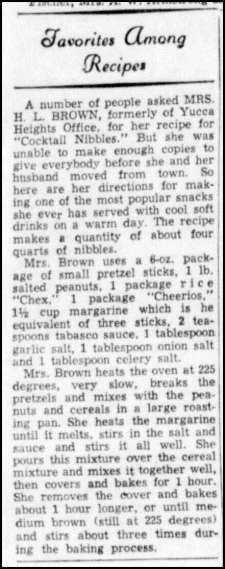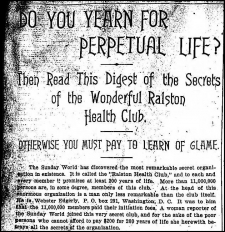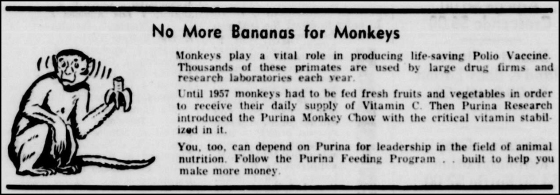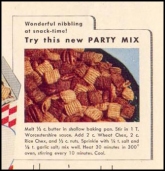Another riff on party mix, Texas Trash, you know the kind of thing. Or… do you?
For all of the obsession that people have with Chex Mix and having the “original” or “authentic” recipe, they’re all wrong unless they have shredded wheat in them.
But before we get to that, let’s start with the recipe on this card, which appeared in the August 8, 1954 edition of The Victoria (Texas) Advocate:
|
Favorites Among Recipes
Mrs. Brown uses a 6-oz. package of small pretzel sticks, 1 lb. salted peanuts, 1 package rice “Chex,” 1 package “Cheerios,” 1-1/2 cup margarine which is the equivalent of three sticks, 2 teaspoons tabasco sauce, 1 tablespoon garlic salt, 1 tablespoon onion salt and 1 tablespoon celery salt. Mrs. Brown heats the oven at 225 degrees, very slow, breaks the pretzels and mixes with the peanuts and cereals in a large roasting pan. She heats the margarine until it melts, stirs in the salt and sauce and stirs it all well. She pours this mixture over the cereal mixture and mixes it together well, then covers and bakes for 1 hour. She removes the cover and bakes about 1 hour longer, or until medium brown (still at 225 degrees) and stirs about three times during the baking process. |
While Victoria, Texas has a population of around 67,000 today (and counting), in the 1950s, its population was closer to 16,000. I’m not saying this was a small town newspaper or anything, but you can click here to see the stories next to this one.
As for why Mrs. H. L. Brown moved, I’m not sure, but I do know that there was a Howard L. Brown in Victoria in the 1930s, and another Howard L. Brown was born in Victoria in 1954, just when this move took place. So it’s possible Howard Junior needed a yard to play in, but I’m just speculating.
Now, the story we’re generally told about Chex Party Mix, brief as it is, is that the recipe first appeared on the cereal box in 1952 and it was an instant hit. Both of those things are more or less true. But there are two wrinkles to that:
- The first one — the bigger one — is that, in its original iteration, Chex Mix had bite-size shredded wheat in it. Because, at the time, Wheat Chex were bite-size shredded wheat.
- While the 1952 Chex Party Mix caught on eventually, the manufacturer had been trying to make people eat buttered cereal since the 1930s (and judging by recipe boxes, largely failing).
Ad for Wheat Chex (“Shredded Ralston”) from a 1951 Life magazine. Click to enlarge the original on the left.
Sigh. I guess to really tell this story, I need to go back to the 1890s, and talk a little bit about Webster Edgerly, the founder of Ralstonism. As many of you may remember, the 1952 Wheat Chex were produced by Ralston Purina, so if we’re going to really look at what made this snack mix happen, we look at what Wheat Chex were supposed to be accomplishing.
Ralstonism
|
Sketch of Webster Edgerly from the April 18, 1896 edition of the Ironwood (Michigan) News-Record.
|
I couldn’t possibly capture for you in this space the entirety of weirdness that was Webster Edgerly.
In fact, I’m going to put most of this section behind “click to expand” tags, because we would get seriously derailed trying to grasp the massive pile of oddity that is Edgerly. And I’m not even starting at the beginning.
We have to skip ahead — past his birth in 1852 in Massachusetts, past his series of failed marriages, past his law practice, past his move to the nation’s capital, and past his failure as an actor and playwright (during which he adopted the pseudonym Edmund Shaftesbury to attempt to convince people the author wasn’t also the lead actor).
But I wouldn’t be doing my job if I didn’t try to capture, at least a little bit, the truly odd ideas of this man.
Click here to expand an example of the ideas introduced in one Edgerly pseudo-scientific text.
|
In 1888’s Lessons in the Mechanics of Personal Magnetism, Edgerly (as Shaftesbury) explained the “scientific basis” for his belief in personal magnetism — the idea that we can draw other people to us without their knowing.
In short, it has to do with “lumeniferous ether,” which was the hypothetical substance that scientists used to think filled the universe and through which light waves moved. Edgerly’s theory boils down to the idea that, as light waves move through ether,1 so too does the electrical charge carried in our bodily humors,2 which can then affect an attractive force on other peoples’ bodily humors and mind.3 To which the following footnotes are applicable: In fact, the existence of “luminiferous ether” was disproven one year prior to the publication of Edgerly’s text at Case Western Reserve University, where an attempt to measure light’s movement in the ether was unsuccessful and we had to face the idea that space is a real, actual vacuum. Einstein, among others, eventually helped us wrap our heads around the idea that light exhibits characteristics of both a wave and a particle. |
In 1896, Kate Swan with The New York World joined the Ralston Health Club to write an exposé on them. She particularly focused on how the “secrets” they revealed were either common knowledge or had no scientific basis, and on a made-up word, “glame,” which apparently is supposed to refer to some kind of self-induced euphoria the members could experience. She also mentioned how the club promised its members would live to 200.
Click here to expand some excerpts from the article.
Some excerpts from the February 23, 1896 edition of The New York World:
|
Do You Yearn For Perpetual Life?
—– Then Read This Digest of the Secrets of the Wonderful Ralston Health Club. —– Otherwise You Must Pay To Learn Of Glame. —– The Sunday World has discovered the most remarkable secret organization in existence. It is called the “Ralston Health Club,” and to each and every member it promises at least 200 years of life. More than 11,000,000 persons are, in some degree, members of this club. At the head of this enormous organizations a man only less remarkable than the club itself. He is Webster Edgerly, P.O. box 291, Washington, D.C. It was to him that the 11,000,000 members paid their invitation fees. A woman reporter of the Sunday World joined this very secret club, and for the sake of the poor persons who can not afford to pay $200 for 200 years of life she herewith betrays all the secrets of the organization. |
|
|
To the glame student the following extract from one of the books that cost me $1 each may be interesting:
“To a person who has once felt true glame the following method of drawing it at will from the oxygen in the lungs will be understood and appreciated: “a. Take a gentle breath very calmly. When the lungs are easily full, but not crowded, close the hand so lightly that the most delicate pressure is felt. Think of the happiest prospect possible in your heart. A flutter of ecstasy will follow so plainly that its presence will teem with vitality. Force, haste, impatience, ill-humor or disbelief will destroy all chances of drawing glame. “b. Repeat the foregoing exercise by the will alone, without any action of the hand. “c. If stupidity, sluggishness or ennui may be classed as your troublesome attendants, draw glame and see how quickly they disappear. Some persons cannot or do not acquire glame.” |
If I were not a good Ralstonite I might say that the books contain a lot of twaddle and a good deal of cribbed matter from medical works and encyclopedias put together in a very ingenious and taking way, but as a Complete Ralston Member it would be rank heresy to say any such thing.
In conclusion I would not advise any one to become a Ralstonite. Wait for two hundred years and see how it works. Then, if it is a demonstrated success, it will be time to join it. Maybe by that time Edgerly will let the whole world into the secret — at half rates. Great is glame, and Edgerly is its prophet. KATE SWAN. |
Autocorrect insists that by glame I mean either game or lame, and I can’t choose between those two. I should point out, by the way, that the supposed 11,000,000 members was Edgerly’s claim, and that the number was probably much lower.
|
Ralston Day is on the first Tuesday in every month. “On this day,” says the book, “the body should be clean. As soon as dressed, open the window and get 100 breaths of pure air.”
Then you exercise for one minute. Next you eat a breakfast beginning with cooked grain and milk. Every breakfast, the Ralstonites say, should begin, the year round, with cooked grain. No particular brand of grain is mentioned, which is a chance to make money that the Ralston Club neglected. (Emphasis added.) |
Four months later, this ad appeared in the back of the June 1896 edition of Everyday Housekeeping:
To be fair to Edgerly, the idea had crossed his mind before. In 1895, ads appeared for Ralston Kaffee, a roasted grain breakfast drink (as Ralstonites were also supposed to abstain from coffee, tea, and liquor), sold directly by the Ralston Health Club. But even 120 years ago, it wasn’t that simple to bring a product to the mass market.
Fortunately for Edgerly, he didn’t have to. Two years before Swan’s expose, William Danforth of St. Louis had founded Purina Mills, a company that sold animal feed. Readers of a certain age no doubt remember Purina Puppy Chow; readers of a certain higher age might even remember ads for Purina monkey chow.
By 1896, then, Edgerly had the problem that he couldn’t manufacture his breakfast food to scale; Danforth had the problem of expanding into human food after selling animal food (in hindsight, it might’ve been easier to try going the other way).
The result was Ralston Purina Cereals. The original “Ralston Breakfast Food” was a hot milled wheat cereal, which is a polite way of saying gruel. From there the line expanded to grits, oatmeal, pancake flour, and beyond.
But the cereal we’re interested in — Shredded Ralston — doesn’t show up in advertisements until the mid-1930s. So Webster Edgerly never had it, because he died in 1926. That makes him about 74, which would be an impressive age for the day, if he hadn’t promised to know the secret to living to 200.
The Long Process of Selling Savory Breakfast Cereal
In the modern mega-corporation world, companies know the best way to get all of your dining dollars is to offer a range of products that appeal to your varying tastes throughout the day. But in the first half of the 20th century, the way most companies did it was to convince you that you wanted to eat the product they made all the time.
Ralston didn’t invent this; nearly every food manufacturer of the day attempted it to one degree or another, a practice maybe most recently remembered for the "drink Dr. Pepper hot!" campaign in the 1960s.
But what makes Shredded Ralston/Wheat Chex stand out is how long the company pushed one specific application: buttered, salted, and served a snack. From the February 3, 1938 edition of The Big Spring (Texas) Daily Herald, this suspiciously un-bylined or -datelined piece is the earliest I’ve found so far:|
Cereal Can Be Made Into An Appetizer
Clever hostesses serve refreshments as individual as their own personalities and conversation. They are the “women of wisdom” who get away from the fiatness and sameness that spoils so many parties. Here’s a trick we picked up from these smart ladies, and we’re passing it on to you with every assurance you’ll find it equally as delicious and unusual as we did. Next time you’re planning to serve hot or cold drinks to your guests, give your refreshments a new and delightful push into society by lifting them out of their salted nut groove and giving them a real debut with Shredded Ralston. Yes, we admit it. It is a cereal. But it’s more than that. It’s a new taste sensation as an appetizer. Melt four tablespoons of butter and mix two cups of Shredded Ralston, the amazing new delicious bite-size cereal that comes in the familiar checkerboard box. Turn into a shallow pan and sprinkle with three-fourths of a teaspoon of salt. Then, into a moderate oven (350 degrees F.) for 15 minutes or toast until crisp. Two cups of Shredded Ralston fixed this way will serve 6 people, and a single box will serve a large party, although guests do some back for repeated servings. Shredded Ralston prepared and served this way is a natural companion to iced drinks, cocktails or fruit juices. And, on chilly nights, it’s fine with coffee or cocoa. When soup’s the main dish, you can salt and butter Shredded Ralston to make croutons to go with it. |
Here’s a magazine ad and recipe from around 1940, which points out that Shredded Ralston is “not rationed!”
|
Easy Treat for Parties
Melt 4 tsps. butter or other shortening in skillet. Add 2 cups shredded ralston. Sprinkle with 1/2 tsp. salt. Stir while heating about 5 min. Serve as nuts, as croutons in soup.
|
This 1947 reproduction (sorry, can’t find the original, but someone’s put it on a metal sign on eBay) omits the quantities of butter and salt to use in favor of the serving suggestion of stuffed celery and pickle chips.
|
Bite Size Party Appetizers
Just add Shredded Ralston to melted butter in pan. Salt to taste and stir until piping hot (about 5 minutes). Serve with stuffed celery and pickle chips… They’ll go fast. |
And on the 1954 Wheat Chex box — the one on the shelf the same year the recipe on this card was printed in the Texas paper — there’s another iteration, this time with celery seed or poppy seed as an option:
|
Buttered ‘N Salted Wheat Chex
Melt 3 T. butter or margarine in large skillet over low heat. Add 2 c. Wheat Chex Stir gently until all Chex are covered with butter. Sprinkle evenly with 1/2 tsp. salt. Continue to heat and stir until the Wheat Chex have been heated for a total of 5 minutes. Spread out to cool. Savory Wheat Chex
Follow above recipe. Add with the salt 2 tsp. poppy or celery seed, or 1/2 tsp. onion powder, or [1/3? 3/8ths, possibly?] tsp. garlic salt. |
There are dozens of other examples, but you get the picture.
So when did Wheat Chex become, y’know, Wheat Chex?
As opposed to shredded wheat, I mean. And on that, I’m not entirely sure. In 1960, the ads still show shredded wheat. By 1970, the commercials show modern Wheat Chex. I’ve reached out to General Mills to ask if they know, but who knows if I’ll hear back.
But one thing is clear: in 1952, when the “famous” “original” Chex party mix recipe appeared, Wheat Chex were shredded wheat.
Here’s the recipe from an ad in the June 16, 1952 edition of Life magazine:
|
Wonderful nibbling at snack-time!
Try this new party mix Melt 1/3 c. butter in shallow baking pan. Stir in 1 T. Worcestershire sauce. Add 2 c. Wheat Chex, 2 c. Rice Chex, and 1/2 c. nuts. Sprinkle with 1/4 t. salt and [1/2?] t. garlic salt; mix well. Heat 30 minutes in 300 deg. oven, stirring every 10 minutes. Cool. |
From the box of H.P., sold in Paradise, Arizona.
6 oz. pkg. pretzel sticks
1 lb. salted peanuts
1 pkg. crisp rice cereal
1 pkg. crisp oat cereal
1-1/2 cup butter or margarine
[But see the comment from Elise Pemberton below suggesting 1-1/2 sticks, not cups]
1/4 cup Worcestershire sauce
1 Tablespoon garlic salt
1 Tablespoon onion salt
1 Tablespoon celery salt
Break pretzel sticks into even smaller pieces and mix with peanuts and both dry cereals.
Heat butter until melted and stir in the Worcestershire sauce, garlic [salt] and various salts. Pour over cereal mixture and mix well.
Cover and bake one hour. Remove cover and bake another hour; stir occasionally.
Makes 4 quarts nibbles — store in tight tin. Oven 225 deg.
























Hi, this is WAY too much butter.. she must have meant 1 and1/2 sticks of butter – not 1 1/2 Cups!
Huh. You know, in doing all that research I didn’t think about it too deeply, but that does seem like a huge amount of butter. I added a note in the recipe about your comment. Thanks!
Oooof, you’ve just recalled something I haven’t remembered in decades: a neighbor who’d evidently erred on the 1 1/2 cups-side of the recipe. I remember her standing, in great distress, over a roasting pan in which scorched cereal squares floated in a sea of sizzling margarine, or “oleo,” as all the ladies (including my mom) called it… I can even smell it!